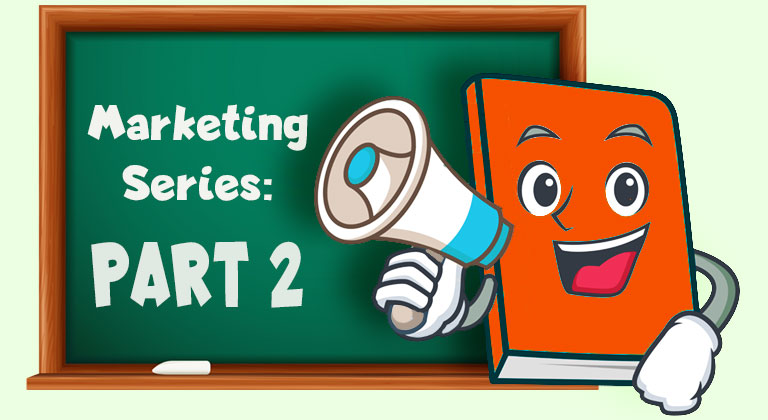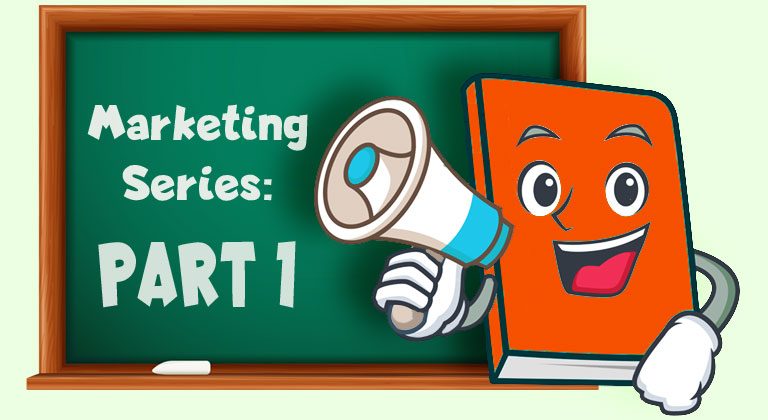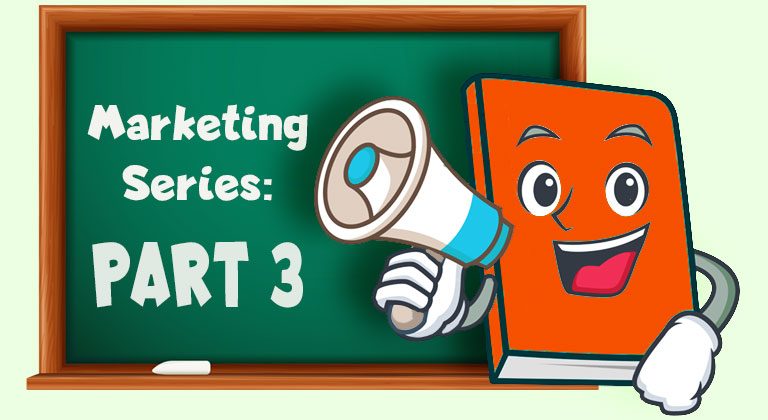Ginger’s Guide to Marketing & Advertising Your Books: Part Two – MARKETING
As we discussed in part one, actually writing your book is only the first step of your journey as a self-published author. The path to success has many hurdles, but our four-part series aims to clear them all away. In this week’s installment, veteran self-published author Ginger dives in deep, giving you everything you need to know about how to market your book effectively.
Last week, I spoke about the importance of marketing and advertising when it comes to your self-publishing career, and recently that’s become more important than ever. In the past, every book page you visited on Amazon was stuffed with thumbnails of ‘also boughts’ – books that were purchased by the same customers who bought the book you’re looking at. Being included in that list was a fantastic – and totally free – way to drive potential customers to your own book. In the last few weeks, Amazon has been experimenting with replacing the ‘also bought’ section with another row of promoted – as in, paid-for – books; making your book even more difficult for customers to find on their own.
That’s why a thorough grounding in marketing and advertising has become more important than ever.
In my first post I gave an overview of marketing, promotion and advertising and how it might pertain to your book. Today we’re going to do a deeper-dive into one specific aspect of book promotion – marketing.
Note: While many of the examples in this article are specific to Amazon, the overall concepts can be applied more broadly to other sites as well.
What Is Marketing?
If you’re not immediately sure what the difference between marketing and advertising is, don’t feel bad – most people outside of the industry don’t. Advertising is actually part of marketing – it can’t exist without it.
Essentially, marketing is the strategy in which you intend to expose your product to the external world – and, hopefully, paying customers. It refers to everything about your book that might inspire people to buy it – from your cover and blurb to the audience you promote your book to, and how you do it.
Within the umbrella of marketing are countless different disciplines. Your cover and blurb are the marketing tools for your book. Your author page on Amazon and your website are the marketing tools for you, as an author (or your pen name.) Your social media accounts are another aspect of marketing, and anything you do to interact with potential readers – like blog takeovers, interviews or the like – are the public relations part of marketing. Then there’s advertising itself; and the materials you use to advertise with.
Ultimately, marketing should be a holistic thing; and the theme, focus and spirit of your book should feel the same wherever and however potential customers learn about it.
Getting Started
Okay, so now you know (roughly) what marketing is – but how do you get started?
Let’s say you’re a first-time author, you’ve written and published a book, and now you want to go about getting people to find out about it (and potentially buy it.) This is where you need to assemble a marketing strategy for your book.
The first thing to know about marketing, as opposed to advertising, is that it doesn’t need to cost anything. What you’re doing is setting up an infrastructure for your book and any advertising you do in the future will either leverage this infrastructure or drive people towards it (which will, ideally, lead them to moving on to your book itself.)
The first thing you need to do when coming up with a marketing strategy is to establish what assets you have to work with.
Asset #1: Your Amazon Product Page
Congratulations – by self-publishing your book on Amazon, you’ve automatically got yourself a seat at the biggest marketplace on the planet. In my first post I wrote about the ‘wild west’ days of self-publishing, in which merely publishing a book on Amazon was enough to get people to buy it – and while the impact of that has diminished, the essential mechanics remain the same. With your book and it’s product page on Amazon, you’re part of the most powerful commercial search engine and online marketplace in the world.
This should be where any marketing strategy starts – as your product page is the final destination any potential customer will reach. You want to make it as inviting as possible, and get a potential reader eager to click the ‘buy now’ button.
Here are some basic things you want to think about:
Cover
The cover of your book should be visibly-appealing, and make people want to buy it. The old adage goes ‘don’t judge a book by its cover’ but as I’ve written about before, most customers do just the opposite, making cover design of paramount importance.
A picture tells a thousand words, and at a glance a potential customer will use your cover to decide (fairly or not) a number of things, such as:
- Does your book stack up against other popular and mainstream books, or does the cover make it look “homemade”?
- Does our book match their favorite genre or sub-genre?
- What is the ‘feel’ of the book?
Investing in a solid cover is an essential part of success in the self-publishing industry, and does wonders to sell even “free” books. We’ve noticed that regardless of content, books that go through our ARC program with solid, professional looking covers get far more sign ups than books with more amateur looking covers. That was one of the reasons why we decided to launch our own cover design services, as a way to help authors make their books more competitive.
Regardless of whether you want to create your own cover or have someone else handle it, make sure to do some careful research of books that are in the same genre as yours. Keep in mind that styles and trends tend to change over time, so what was popular when you first started your book may have changed near the end. That’s one of the reasons many authors don’t create their covers until after their book is written and they’re closer to their publication date. Also remember that your book cover will sometimes be displayed as a tiny thumbnail, so make sure the title is clear and easily readable.
Blurb
If your cover design succeeds in drawing clicks from potential customers, the next thing they’ll see is your book description, or blurb. This is another vitally important section to get right, and it’s worth diving as deep as possible into how to craft the perfect blurb to sell your book. But for the sake of this article, we’ll cover a few tips now.
While there are no hard-and-fast rules about what should or shouldn’t go into a blurb to help sell your book, it’s worth remembering that there’s a reason many genres have certain conventions when it comes to their blurb. My advice is to do some careful research of books similar to yours, and see what seems to be common among the more successful books. Three very important pieces of advice are these:
- Make sure your blurb is easy to read and understand (read it out loud before you publish it.)
- Remember that Shakespeare said ‘brevity is the soul of wit.’ Keep your blurb clear, and concise.
- Make sure your blurb is perfectly edited. Nothing suggests to a reader that a book will have sloppy editing like a typo in the book description.
Sadly, almost as important as the words themselves in a blurb is the layout. If you trawl through best-sellers and self-published books on Amazon, you’ll notice one common difference: A lot of the more popular books have ‘fancy’ blurbs featuring bold text, italics and bullets. In the space in which you write your book description in your KDP dashboard there’s no apparent way to include any fancy formatting; and this is where you can give yourself an edge.
Amazon use a very basic form of HTML to enable authors to add formatting to their blurb – and you can either learn how to use that yourself (it’s pretty easy) or use a blurb editor like ours to do it in a similar fashion to a word-processor. Then you simply copy and paste your HTML script into your product description window, and when your book goes live your blurb will be as fresh and fancy as all those traditionally-published best-sellers.
Categories and Keywords
When you publish a book – especially a fiction book – you’ll have the opportunity to pick certain keywords and two categories for your book to be featured in. A lot of new authors will not be aware of just how important these two elements are; or how they interact with each other. Getting them right can make all the difference.
Amazon, as you might know, categorizes books by their genre and type – drilling down from ‘fiction’ and ‘non-fiction’ to incredibly-specific categories like ‘time travel romance’ and ‘terrorism thillers.’ What you might not know is that most readers of fiction books, especially, will search for new reading material by clicking on the specific category of books they want to read, and seeing what’s new. Getting your book highly-ranked in the right category can be the instant difference between success and failure; even before you spend a penny on advertising or promotion.
Another thing you might not know is that your keywords can specify your category – so use them well. For example, even if you pick the categories ‘romance’ and ‘paranormal’ when you publish your book on Amazon, if you use the keyword ‘vampire’ you will drive your book to be included in the romance>paranormal>vampire category.
What difference does this make? Well, remember when I told you that a lot of fiction readers will browse for new reading material by category? Sometimes they do so by very specific category; and it’s much easier for your book to be highly-ranked (and more visible) in a sub-category like romance>paranormal>vampire than in the more general romance or even romance>paranormal categories.
They’re no longer easily navigable, but Amazon has included ‘cheat sheets’ for keywords in the mystery/thriller and romance categories, and also general guidelines on picking keywords.
And of course, aside from helping place you in categories, the main goal of keywords are to allow searching customers to find your book easier. When a customer types one of the keywords you used into the search bar, your book will be one of the ones found. So it makes sense that you use as many keywords as possible to describe your book, or anything you think readers may search for that is relevant to your book.
Amazon provides seven fields to enter your keywords in, so be sure to use them all – you can even enter multiple keywords or keyword phrases in each box. Many authors believe that a key ingredient in the secret sauce to success is keyword selection, and as such are very secretive about which words they use. Amazon doesn’t show anyone which keywords are used by any given book, nor do they provide keyword data to anyone via any of their tools or APIs. The only way to really know if a book is using a specific keyword is to type that keyword into the search box and see if the book in question is one of the results.
Unfortunately, the secrecy around keywords and the fact that authors believe them to be so important has led some companies to make unfounded or misleading claims about their ability to determine keywords or provide authors with some keyword advantage. Be wary of what these companies offer, and understand that they are subjected to the same limitations as everyone else. Before you paid them any money, be clear about what it is they are really delivering.
Other Product Page Details
The final thing to think about on your product page are the other details you can add. Once again, it’s not immediately apparent through the KDP dashboard how to add your author information or editorial information to a book, but if you visit authorcentral.amazon.com and login with the same account details as your KDP dashboard, you can ‘claim’ your book and connect it to a centralized author page, and add additional details like editorial reviews.
As you write and publish more books, this becomes more and more important. Just remember one thing – changing any of the product information (such as the blurb) will overwrite what you originally published the book with. Secondly, and more importantly, if you subsequently edit your book through the KDP dashboard, that in turn will overwrite any information you’ve changed through Author Central.
Asset #2: Your online profile
By setting up your product page, keywords, categories and author information, you’ll automatically be putting yourself in a good position to promote your book; and a lot of promotion will happen organically, behind the scenes, by way of Amazon’s marketing algorithms.
The next stage is to continue your marketing efforts beyond Amazon – and how far you want to take this is up to you. Setting up an online presence is a great way to connect with potential readers outside of Amazon, and also target new readers.
Here are some key things to consider:
An ‘Official’ Email Address
Nothing says ‘self-published author’ like a gmail or Yahoo email account. I strongly recommend that any author who’s serious about their publishing career invest in a domain name relevant to their name or pen name, and set up an email address from it. That means authorname@gmail.com becomes info@authorname.com, or something similar.
Services like GoDaddy or Bluehost offer the ability to purchase a domain name and set up an email account easily and affordably – generally for less than $50 a year. They also have instructions to connect it to your day-to-day email service; so you can check your author email and send messages from it right through your gmail or Yahoo account.
In addition to looking infinitely more professional, your own unique domain enables you to leverage email marketing (a powerful tool we’ll talk about in our installment on promotions) and also ‘white lists’ you from getting your emails caught in spam filters.
An Author Website
Since you’ve already bought a domain name for your email address, why not have a website as well?
Having your own website – for you, or your pen name – is a great way to look like a ‘real’ author. However, it’s also a great way to look like a haphazard hack if you do it clumsily! This is why I generally recommend that authors approach their outside-of-Amazon presence through channels like Twitter or Facebook first; as those are much more manageable. However, there are a great many ways in which a website can be useful, such as:
- Post and share blogs – give readers a reason to keep coming back and visiting you between books by posting about your progress or things of interest to your readers
- Get discovered by Google or other search engines – Your website and content will be indexed by search engines, allowing new readers to find you
- Earn extra money – A popular website can be monetized in many ways, such as ads or selling your books or branded merchandise to fans directly – but also through Amazon’s affiliate links. These links direct readers to Amazon to buy your books (or other products you promote) while returning a small percentage to you for each purchase that person makes after following your link. You can even earn by pointing readers to other things that may interest or benefit them, like Kindle Unlimited memberships, free trials and books from audible so they can listen to your audiobooks, or even just getting them to download the free kindle reading app so they can read your books on any device
If you’re considering setting up a website, keep things simple. You might also find it worth your while to pay somebody a modest amount to set it up for you – as opposed to trying to figure out how to do it yourself. The only thing to remember is to try and keep ‘possession’ of any assets you have online. That means register them in your name, and make sure you have all the passwords and login information.
There’s nothing worse than investing in a website and then having your website creator disappear on you, taking the ownership and access to the domain information with them.
A lot of modern businesses are shunning websites entirely and operating entirely through a Facebook ‘page’ – and it’s something I’d consider too. Facebook is one of the most powerful networking tools on the planet – and it’s perfect for authors to get in touch with potential readers. It’s also an incredibly powerful tool for advertising (more on that in Part Three.)
I won’t go too far into Facebook in this section, but there is one very important detail you need to know:
Facebook exists in two forms. There are ‘accounts’ for people (like you probably already have) and there are ‘pages’ for businesses. A lot of authors make the near-fatal mistake of creating an ‘account’ for their pen name, or trying to market their books through their Facebook account. Never do this!
Facebook is constantly cracking down on ‘fake’ accounts – especially now, when Russian trolls are using fake profiles to drive news stories, and online gamers are creating fake profiles to bolster their score (some people are WAY too committed to Farmville.) If you create an ‘account’ for your pen name, you will eventually have it deleted. If you use that account to access a Facebook page, you’ll also lose access to that – which will instantly kill your Facebook profile.
If you write under your own name, you should also avoid using your personal account to promote your work. Facebook accounts are limited in the number of ‘friends’ you can have, and do you really want readers of your books to have access to your personal information anyway? To have access to all those pictures of your kids or family that you share? Besides, you can’t promote or advertise personal posts through an ‘account’ so you would be hobbling yourself immediately.
Instead – and this is a must – create a ‘Page’ on Facebook. Treat your writing career – whether you publish under your own name or a pseudonym – as a business; because essentially that’s what it is. Creating a Facebook ‘page’ is simple and straightforward – and you can have a limitless number of ‘fans’ when you do so, as well as have access to Facebook’s powerful advertising platform.
Worried that tying your author page to your personal account will allow everyone to see the connection? Don’t be.
Unless you ‘like’ your own page or invite your own friends and family to join it, your connection to a Facebook page is utterly invisible. You can operate a steamy pen name page through your personal account and nobody will ever know. Facebook keeps that information utterly anonymous; and the only reason they connect it to your ‘real’ account is so they know that behind the scenes a real person is operating it.
Goodreads
About five years ago, Amazon acquired the website Goodreads – a site dedicated to connecting authors with their readers. As an author, you’re entitled to a Goodreads account for you or your pen name; and many authors swear that it’s one of the best ways to find and interact with new readers.
Definitely consider it for yourself – but I offer one warning (and it’s why I don’t use Goodreads myself.) They can be a rough crowd. Authors have to tread lightly as disgruntled readers can sometimes ‘dogpile’ on authors they don’t like; and it can get ugly.
We’ll look deeper into Goodreads at a later point, but I’d be remiss if I didn’t highlight it as an important part of any potential marketing campaign.
Social Media
Facebook earned its own section, but I’ll include the rest of social media as a big bundle. Whether it’s Twitter, Pinterest or YouTube, you have the potential to create social media accounts for your pen name and interact with potential readers through them – and in general the pitfalls of doing so are much less than with Facebook.
Personally, I recommend focusing on what you think works best for your personal style. I know plenty of steamy erotica authors, for example, who use Tumblr to promote their books because it’s a great way of reaching out to people engaged in the same saucy kinks as they are. There is a powerful and supportive author network on Twitter, and it’s one of my favorite platforms to use. I have a number of friends and co-authors who enjoy using video, too, and YouTube is the platform they enjoy.
You could write an entire book on social media for the author, and I’ll cover some specifics in terms or promotion and advertising in later posts. However, in terms of marketing, this is something you should look into – and also bear in mind these two points:
Only create accounts you can regularly update and manage. A lot of ambitious authors will create a Facebook page, Twitter account, YouTube channel and more… And then fail to update half of them. I recommend only creating accounts in platforms you’ll know you’ll use. Having worked in social media for years, I call it the ‘sausage factory’ – as regularly updating and maintaining a social media account can be incredibly time-consuming without necessarily providing much of a return. Therefore keep things focused and manageable.
Remember, what goes on social media stays on social media. Another thing to be aware of is that anything you do or say on social media will stay there. If you’re one for political rants, inappropriate memes or arguing online, try to keep that aspect of your personality separate from your marketing social media accounts. If not, you might find something you once said – even years earlier – might come back to haunt you when you least expect it.
Marketing in a Nutshell
We’ve covered a lot of ground in this post, yet barely scratched the surface! However, it should be enough to give you a good grounding in terms of how to market your book effectively, or at least give you some ideas of how to get started.
Next week we’ll cover Advertising – which will build on some of what we’ve gone over in this post. In the meantime, if you have any specific questions or anything you want to add, let’s hear from you in the comments below. And if you found this post useful, please consider sharing it with your fellow authors on any of the social sites by clicking the icons below.
Until then, keep writing and I’ll see you next week!












3 Comments